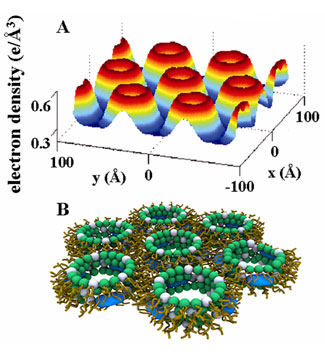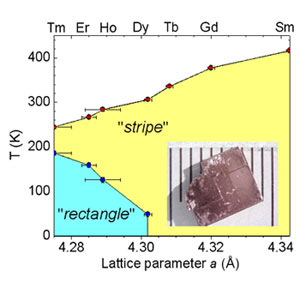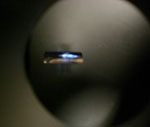

Contents of this Issue:
1. Science Highlight —
Scientists Decipher Mechanism behind Antimicrobial "Hole Punchers"
(contacts: L. Yang and G.C.L. Wong, University of Illinois at Urbana-Champaign)
 | |
| (A) Electron density profile r(x,y) of the 2-D unit cell for complexes formed by the specifically active AMO-2 and DOPG:DOPE = 20:80 lipid membranes confirm the inverted hexagonal structure. (B) A proposed model of the unit cell is shown. |
To learn more about this research see the full scientific highlight at:
http://www-ssrl.slac.stanford.edu/research/highlights_archive/amo.html
(from a University of Illinois Urbana-Champaign press release)
2. Science Highlight —
Controlling the Wave
(contacts: N. Ru and I.R. Fisher, Stanford University)
 | |
| Phase diagram of the rare earth tritellurides, determined from a combination of diffraction and resistivity measurements, as a function of lattice parameter (top axis labels the rare earth). Inset shows a single crystal of GdTe3 over a mm scale. |
To learn more about this research see the full scientific highlight at:
http://www-ssrl.slac.stanford.edu/research/highlights_archive/cdw_compounds.html
3.
Budget Impact on SSRL User Operations
As you may already know, the FY08 budget for science was much less than expected. This will likely result in reduced operational hours at many DOE funded facilities, including SSRL. We are currently assessing the situation and discussing the potential impact on user operations with the DOE and with the SSRL Users' Organization Executive Committee. As of now, we anticipate that the third scheduling period will be reduced by at least 2 weeks in June (and possibly in early August). We plan to use the June down time to install necessary equipment in order to conduct initial AP tests related to top off operation; this will be done on the existing fill schedule of injection every 8 hours (but with shutters open on selected beam lines). Pending approval from DOE and SLAC Radiation Physics, top off mode operation may be continued during the remainder of the run on selected beam lines, but with the majority of beam lines continuing to operate normally with brief interruptions during the daily top off fills at 6 am, 2 pm, and 10 pm. Utilizing this down time in June for top off tests will allow us the opportunity to better understand how the top off mode will impact beam line instrumentation, optics and user experiments. This will provide valuable information needed to proceed with the reviews and approvals needed for more frequent top off mode on all beam lines in the future. Results from these preliminary tests will be shared with users at their next Users' Meeting.
4.
SPEAR3 and Beam Line Update
(contacts: R. Hettel, hettel@slac.stanford.edu and T. Rabedeau,
rabedeau@slac.stanford.edu)
In 2004, SSRL entered a new era with the commissioning of the third generation SPEAR3 storage ring. However, resource limitations forced us to stagger beam lines upgrades as well as upgrades necessary to support top off injection and higher current operation over several budget years. These beam line upgrade/development projects to make beam lines compatible with top off and SPEAR3's 500-mA operation are nearing completion. By the end of the 2008 run, all of the optics, beam transport components, and shielding of insertion device and bend magnet branch lines will have been upgraded. The ability to routinely operate beam lines with top-off injection and/or at higher currents will still be contingent on several safety and readiness reviews.
Regarding beam line upgrades, BL5-1 and BL5-2 have been moved to new locations at BL13-2 and BL13-3 (see separate article). Beam line 4 is currently undergoing an upgrade to be compatible with SPEAR3 low-emittance operations at 500-mA ring current. To date, the BL4 wiggler has been relocated and aligned in its new location in Building 130 (beyond BL11). All front end optic components for BL4 stations have been installed. We anticipate that commissioning experiments on BL4-2 will begin later this spring and that the line will be operational by summer 2008 (see details in separate article). A significant amount of work remains to be completed at BL4-1 (XAS) and BL4-3 (XAS); these beam lines, which have been closed since 2003 pending the move as well as upgrade installation, startup, and commissioning, will likely not be operational until fall 2008 (for the 2009 run).
5.
First Light at SSRL's Newest Beam Line for Soft X-ray Material Science
(contact: M. Rowen, rowen@slac.stanford.edu)
 |
| First light at Beam Line 13 |
The scanning transmission x-ray microscope at BL13-1 will allow the study of magnetic phenomena with a spatial resolution of 40 nm or less using soft x-rays in the energy range between 250 and 1000 eV. In such a microscope, x-rays are focused down to a spot of 40 nm or less onto the sample using a Fresnel Zone Plate. The sample is then scanned perpendicular to the incoming beam, while the transmitted intensity is then detected behind the sample using a photodiode or a photomultiplier. Samples for such a microscope are typically grown on substrates that are transparent to soft x-rays, like membranes made of silicone nitrides. The microscope will be able to operate in an ultra high vacuum environment (<=10^-9 mbar) and in a variable temperature range (25 - 450 K), thus allowing for studying field and temperature dependent magnetic phenomena. It will also be equipped with electrical feedthroughs to apply electric currents and pulses to the sample.
The spectroscopy branch line BL13-2 is dedicated to high resolution soft x-ray spectroscopy for material research. The UHV end station is designed for surface and solid state experiments with ultra-high vacuum compatible samples up to 10 mm in diameter. The end station has an electron spectrometer (R3000, VG-Scienta) for photoemission spectroscopy (PES) and partial electron yield detector for x-ray absorption spectroscopy (XAS). The system is capable of performing XAS and PES experiments with a total energy resolution of 100-200 meV in the energy range between 150 and 1000 eV. A horizontally mounted manipulator is provided for experiments with a minimum sample temperature of about 40 K. The manipulator transfers samples between the preparation chamber and the main chamber. Sputtering facilities, mass spectrometer and LEED optics are available in the preparation chamber. Gas dosing facilities and ports for evaporation sources are also available. In addition to PES and XAS, users will be able to use x-ray emission spectroscopy (XES) under the same experimental condition. XES is a "photon-in photon-out" method to deliver element specific information on the occupied part of electronic structure. The commissioning of x-ray emission system will begin later this spring. The ambient pressure photoemission and specific x-ray emission stations for BL13-2 are under design.
BL13-3 will be tailored for resonant scattering of soft x-rays to study order phenomena on the nanometer length scale and their dynamics like chemical segregation in polymer blends, spin dynamics in magnetic nanostructures or ordering phenomena in correlated materials. Possible experimental techniques include 'small' angle scattering in transmission (theta < 20°) or reflection geometry (2 theta < 20°), scattering of coherent x-rays for lensless microscopy, x-ray photon correlation spectroscopy, and time resolved scattering by synchronizing an external pump with SPEAR3's bunch structure. The main detector is an in-vacuum direct illumination CCD with 1300x1340 pixels from Princeton Instruments. The end station will be equipped with a cryostat (temperature range: 20 - 300 K) and will provide magnetic fields up to 1 KOe. The beam line optics demagnify the source by about 3:1, yielding a divergence of 400 microrad in both the horizontal and vertical plane. The inherent transverse coherence length of the x-ray beam is a few micrometers, which can be increased to several tens of micrometers by reducing the source divergence with apertures.
6.
New and Improved Capabilities for Biological Small Angle X-ray Scattering on
BL4-2
(contact: H. Tsuruta, tsuruta@slac.stanford.edu)
 |
| Beam Line 4-2 for biological small angle x-ray scattering |
7.
The March of the Carbon Nanotubes
(SLAC Today article by Matt Cunningham)
 | ||
| Anders Nilsson and Anton Nikitin at the beam line. |
Current methods for storing hydrogen are expensive and inefficient. Storing hydrogen in tanks made from costly composite materials requires dangerously high pressures of up to 10,000 pounds per square inch. Compressing hydrogen is expensive, and the energy required outweighs the benefits.
Nikitin and his colleagues were able to pack seven percent by weight hydrogen into carbon nanotubes through the formation of bonds with carbon atoms. The chemically grown nanotubes are made of pure carbon and have walls a single atom thick. Because single-walled nanotubes are essentially all surface area, they can theoretically store an enormous proportion of hydrogen, making it a promising storage medium.
Demand for carbon nanotubes - in fields ranging from electronics to medicine - adds to the excitement surrounding this material, but don't expect hydrogen energy to appear overnight. Associate Professor Anders Nilsson estimates that it will be 20 years before all of the pieces come together.
"The world is possibly facing the biggest challenge of modern civilization," Nilsson said, "and science plays a pivotal role in developing a long-term solution."
Everybody at SLAC knows Pief Panofsky and other high energy physics and
accelerator pioneers of the lab, but it is a safe bet that the history and
pioneers of SSRL are less well known. Here I briefly want to tell how SSRL
developed from a hole in the wall (of SPEAR) to an important part of SLAC. My
story tries to capture the SSRL philosophy developed along the way and what it
means today for implementing the vision of "one lab".
The SSRL Users' Organization Executive Committee (SSRLUOEC) thanks everyone who
participated in the 2008 on-line user survey. Results from the survey are being
analyzed and will be posted along with results from the 2007 survey at
http://www-ssrl.slac.stanford.edu/users/ssrluo/.
The survey serves as an important communication channel between the SSRLUOEC
and the larger SSRL user community. We will use your feedback via this survey
to organize the next SSRL/LCLS Users' Meeting, to prepare reports to SSRL
management as well as advisory and review committees, and of course to continue
to improve the overall user experience at SSRL both in science and otherwise.
As an incentive to complete the survey, a random drawing for several prizes was
held among survey participants who provided their contact information. The
winners were: Colleen Hansel, Harvard U. (Free Night at SLAC Guest House);
Frank Huggins, U. Kentucky (Coffee Mug); Carol Cho, UC San Francisco (Coffee
Mug); Ting Guo, UC Davis (Coffee Mug); Jesse Dylan Ward, U. Michigan (Baseball
Cap); Petra Verdino, Scripps (Baseball Cap); Aaron Patrick Holm, Tyco
Electronics (Baseball Cap); Hemant Badgandi, U. Arizona (SSRL Shirt); Edward
Eric Meyer, Dartmouth College (SSRL Shirt); Farrel Lytle (SSRL Shirt); Nalini
Sundaram, UC Santa Cruz (SSRL Shirt); and Alexis Templeton, U. Colorado (SSRL
Shirt).
__________________________________________________________________________
SSRL Headlines is published electronically monthly to inform SSRL users,
sponsors and other interested people about happenings at SSRL. SSRL is a
national synchrotron user facility operated by Stanford University for the
U.S. Department of Energy Office of Basic Energy
Sciences. Additional support for
the structural biology program is provided by
the DOE
Office of Biological and Environmental Research, the NIH
National Center for Research Resources and the NIH Institute for General Medical
Sciences. Additional information about
SSRL and its operation and schedules is available from the SSRL WWW
site.
__________________________________________________________________________
To leave the SSRL-HEADLINES distribution, send email as shown below:
To: LISTSERV@SSRL.SLAC.STANFORD.EDU
Subject: (blank, or anything you like)
The message body should read
SIGNOFF SSRL-HEADLINES
That's all it takes. (If we have an old email address for you that is
forwarded to your current address, the system may not recognize who
should be unsubscribed. In that case please write to
ssrl-headlines-request@ssrl.slac.stanford.edu and we'll try to figure out
who you are so that you can be unsubscribed.)
If a colleague would like to subscribe to the list, he or she should send
To: LISTSERV@SSRL.SLAC.STANFORD.EDU and use the message body
SUBSCRIBE SSRL-HEADLINES
8.
From the SSRL Director: From a Shed to a Directorate of SLAC
(SLAC Today article by Jo Stöhr)
Bill Spicer was a pioneer not just in his chosen field of photoemission
research but as early as June 1968 wrote a letter to Pief Panofsky pointing out
the possibility of using "cyclotron" radiation for solid state physics and
chemistry. At the time, the construction of the Stanford Positron Electron
Asymmetric Ring, SPEAR, was still on the drawing board, but Bill's vision soon
became a reality with the advent of the storage ring SPEAR. Following his and
Seb Doniach's initiative, Burt Richter who was in charge of the construction of
SPEAR, made available resources and help from the experimental facilities
division of SLAC to construct the first x-ray "beam line" on SPEAR in 1972. The
project was driven by Ingolf Lindau and Piero Pianetta, a graduate student at
the time, who together collected the first data with synchrotron radiation from
SPEAR. The picture above gives an idea of the humble beginnings of what was
soon to be called the Stanford Synchrotron Radiation Project, SSRP, funded at
the time by the National Science Foundation (DOE funding started in 1983).

SSRL "research facilities" in
the early days.
Today SSRL is known in the x-ray community for its pioneering role in the
development of synchrotron radiation techniques, instrumentation and forefront
scientific research. Many of the leaders in x-ray science today honed their
experimental skills at SSRP, which in 1977 became an Independent Laboratory of
Stanford University under the name SSRL. The historical path toward the SSRL of
today was all but smooth, and involved many heated discussions within its own
management and staff to find and establish its identity, and the establishment
of a user service model involved tough negotiations with users and
institutions. It was only through these growing pains that the now widely
accepted user service model of SSRL was developed under the leadership of SSRL
Directors Seb Doniach, Artie Bienenstock and Keith Hodgson. The emphasis on the
user as a "customer" and the goal of user satisfaction has shaped SSRL ever
since and has served it well.
Even after SSRL formally became a Division of SLAC in 1992, SSRL maintained
considerable independence from "big brother" SLAC, despite relying on Lab-wide
services such as facilities, purchasing, human resources etc. The underlying
operational philosophy was to make sure that SSRL controlled the resources
required to assure reliable beam delivery to users, such as running and
controlling the injector and SPEAR ring and assuming complete electrical,
mechanical and computer support of beam lines and experimental stations.
Because of the size of SSRL as an organization, its staff is largely organized
in small groups and it is common for people to closely work together and assume
multiple tasks. SSRL has thus benefited from the well known effectiveness of
highly interactive small teams, which in our case is based on the
understanding, pride of ownership and execution of the customer driven service
model.
The question arises how SSRL fits into the bigger model of "one lab", where
planning beyond the divisional boundaries is necessary and where centralization
of certain services can lead to additional opportunities and result in
significant cost savings. We all know examples of centralized services that
work and don't work. To some people at SSRL, the thought of a one-size-fits-all
centralization is outright scary. This problem can only be solved if SSRL
management and staff become part of finding the solution. It involves working
closer together, getting to know each other better and establishing trust. The
SSRL staff needs to keep an open mind to centralizing certain functions while
existing central organizations at SLAC need to realize that certain SSRL
functions cannot be centralized because they are the key to the success of our
user service model. I, for one, am looking forward to the challenge.
9.
The SSRLUOEC Thanks You for Your Feedback
(contact: R. Szilagyi, SSRLUOEC Chair, szilagyi@montana.edu)
10.
Ultrafast X-ray Summer School, June 17-20, 2008
Following up on the success of the 2007 Ultrafast X-ray Summer School
(http://www-ssrl.slac.stanford.edu/pubs/ultrafast07_summary.pdf),
another Ultrafast Summer School has been arranged for June 17-20, 2008. This
five-day residential program will be hosted by Stanford University's PULSE
Center located at the Stanford Linear Accelerator Center.
(http://photonscience.slac.stanford.edu/pulse/index.php) The goal of
the school is to disseminate information about scientific opportunities in
ultrafast science and train students and post docs on the new FEL facilities as
well as to inform researchers who are interested in joining this exciting new
field. Lectures will be presented by expert scientists in the various
aforementioned fields. The attendees will be expected to participate in the
discussions since we plan to offer these lectures in an interactive style mode
to make it effective and interesting to the audience. Register before May 9 to
take advantage of the advance registration fee of $200.
http://www-conf.slac.stanford.edu/uxss/2008/

SSRL Welcome
Page | Research
Highlights | Beam Lines | Accel
Physics
User
Admin | News & Events |
Safety Office